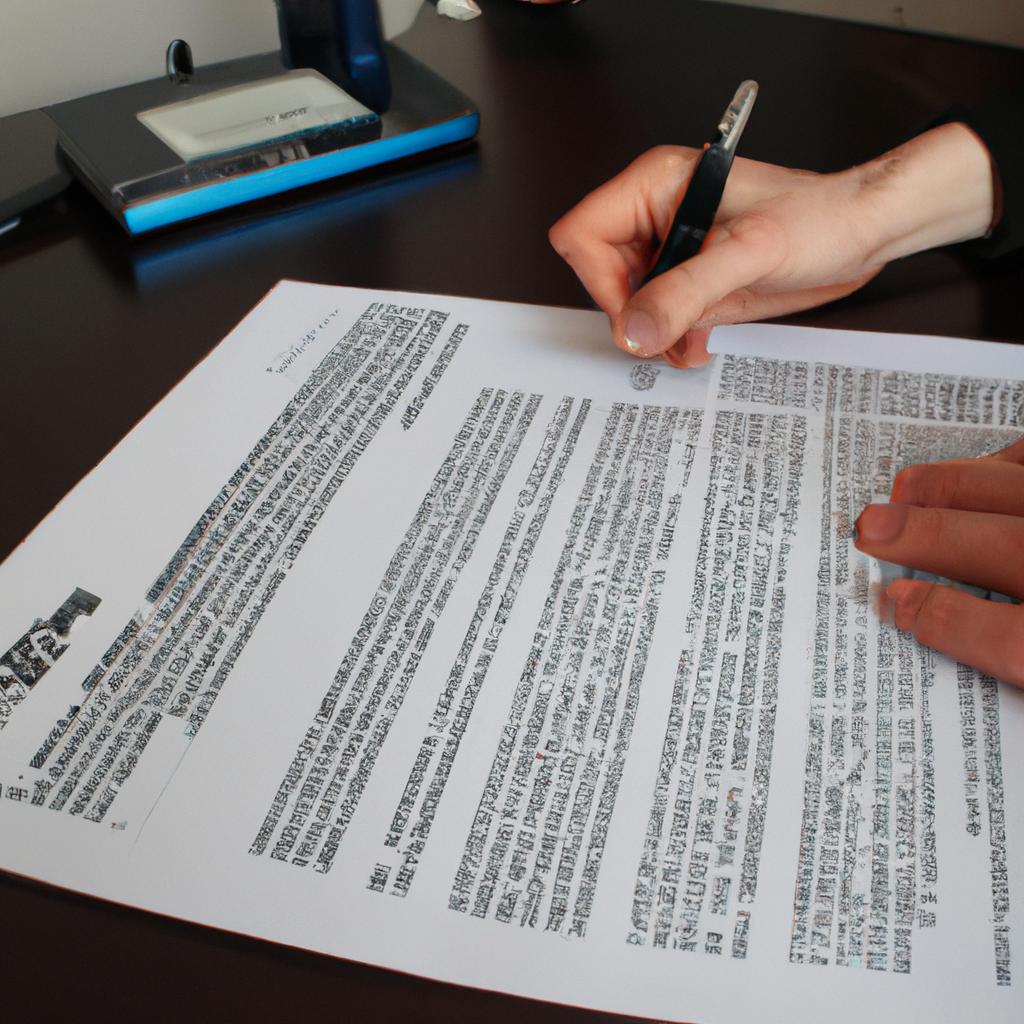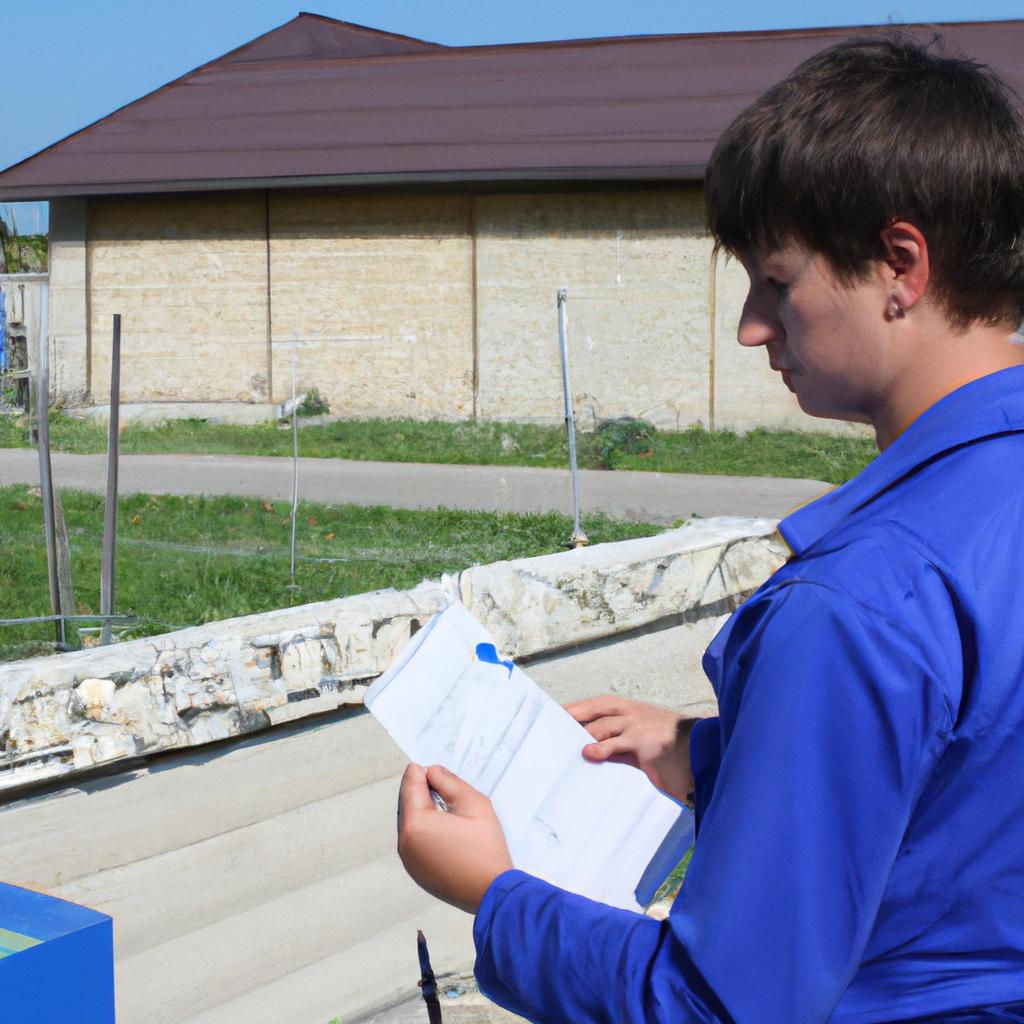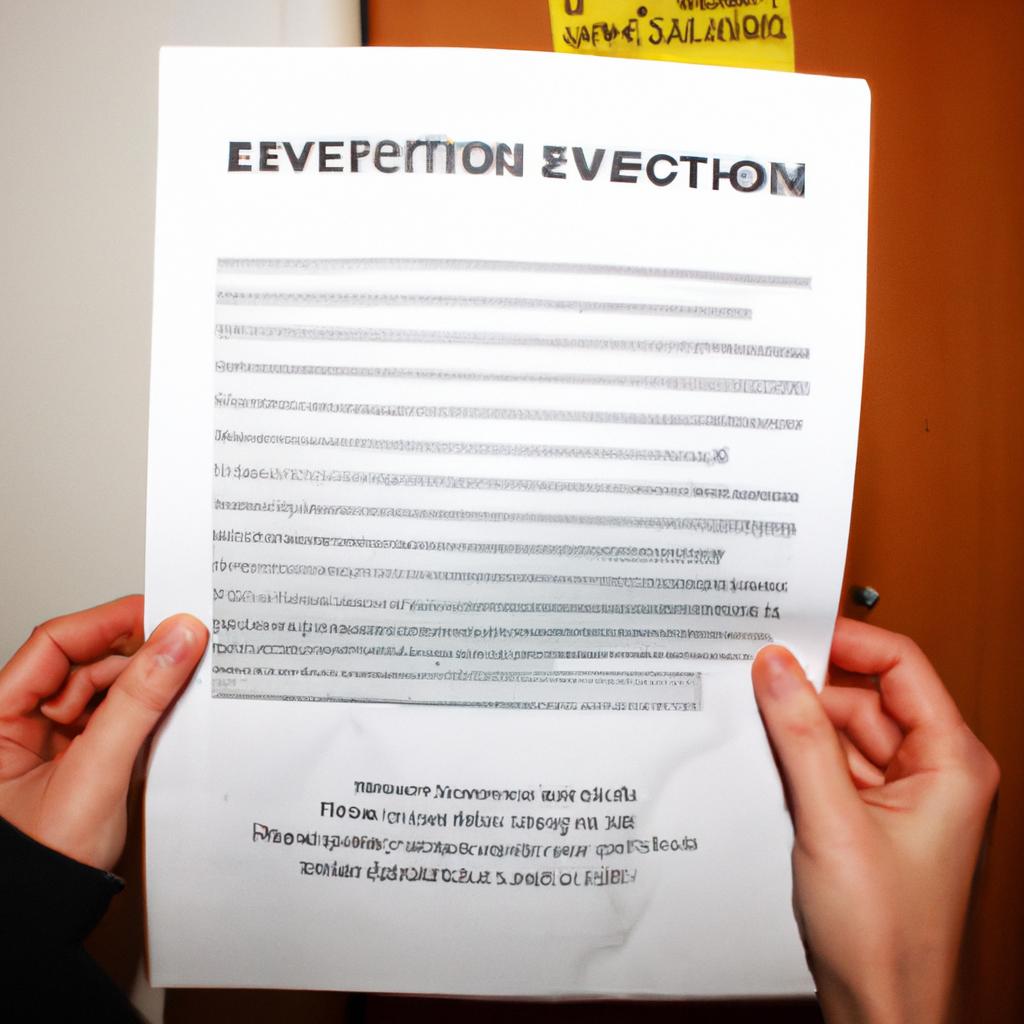One of the most crucial aspects of real estate property management is lease agreements. These legal contracts establish a binding relationship between landlords and tenants, outlining the rights and responsibilities of both parties. Whether it’s a residential or commercial property, understanding the intricacies of lease agreements is essential for effective property management.
Consider the case of a hypothetical landlord named John who owns multiple rental properties in a bustling city. As he navigates through various tenant turnovers and maintenance issues, John realizes the significance of well-drafted lease agreements. A properly crafted lease agreement can protect his interests as a landlord while also ensuring that his tenants are aware of their obligations. Therefore, this article aims to provide key insights into lease agreements in real estate property management, offering valuable information for landlords and property managers seeking to enhance their understanding and implementation of these vital documents.
Understanding Lease Agreements
Lease agreements play a crucial role in real estate property management, serving as legally binding contracts between landlords and tenants. These agreements outline the terms and conditions of the lease, including rent amounts, duration of occupancy, responsibilities of both parties, and any additional clauses or provisions. To gain a comprehensive understanding of lease agreements is vital for all stakeholders involved in rental properties.
For instance, consider a hypothetical scenario where a landlord leases their residential property to a tenant. The lease agreement specifies the monthly rent amount, security deposit required, and the duration of the lease term. It also includes clauses regarding maintenance responsibilities, restrictions on pets or smoking within the premises, and consequences for violating these terms. This example highlights how lease agreements serve as essential tools in ensuring clear communication and establishing expectations between landlords and tenants.
To further emphasize the significance of understanding lease agreements, let us explore some key points:
- Property Rights: Lease agreements protect the rights of both landlords and tenants by clearly defining each party’s obligations. They establish who has control over the property during the agreed-upon period.
- Financial Commitments: Leases outline financial aspects such as rent payments, due dates, late fees, and penalties for non-payment. Understanding these commitments helps foster transparency between landlords and tenants.
- Maintenance Responsibilities: Lease agreements specify which party is responsible for maintaining various aspects of the property—whether it be regular upkeep or repairs—and provide guidelines on how to report issues promptly.
- Dispute Resolution: In case conflicts arise during tenancy, having well-drafted lease agreements can facilitate dispute resolution processes by outlining procedures for mediation or arbitration.
To better grasp these concepts visually, refer to the following table illustrating typical components found in lease agreements:
| Component | Description |
|---|---|
| Parties Involved | Identifies individuals entering into the contract |
| Rent Amount | Specifies monthly payment |
| Lease Term | Duration of the lease agreement |
| Additional Clauses | Any supplementary terms or conditions |
Understanding lease agreements is a fundamental aspect of real estate property management. By familiarizing oneself with their contents, stakeholders can ensure smooth and transparent rental experiences for both landlords and tenants alike. In the subsequent section about “Important Terms and Definitions,” we will delve into specific terminologies commonly used in lease agreements to further enhance our comprehension.
Note: Transitioning from this section, it is crucial to have a solid understanding of important terms and definitions found within lease agreements.
Important Terms and Definitions
Transition from the previous section:
Having gained a comprehensive understanding of lease agreements, it is now crucial to familiarize ourselves with the important terms and definitions associated with such contracts. By examining these key elements, we can ensure clarity and precision in real estate property management.
Important Terms and Definitions
To illustrate the significance of understanding lease agreement terminology, let us consider an example involving a commercial property. Imagine a bustling shopping mall where numerous businesses operate under individual lease agreements. One tenant, a popular clothing store, experiences significant growth in sales and decides to expand its retail space within the mall. In this scenario, both parties—the landlord and tenant—must navigate through various clauses and provisions outlined in their existing lease agreement to facilitate this expansion seamlessly.
To delve deeper into the intricacies of lease agreements, here are some essential terms and definitions that one should be aware of:
- Rent: The amount paid by the tenant to occupy the leased premises.
- Lease Term: The duration for which the property is rented.
- Security Deposit: A sum provided by the tenant as collateral against potential damages or lease violations.
- Maintenance Responsibilities: Specifies whether maintenance tasks fall on the landlord or tenant.
Understanding these fundamental concepts allows landlords and tenants alike to establish clear expectations regarding financial obligations, tenancy durations, deposit requirements, and maintenance responsibilities. Utilizing precise language helps minimize confusion while also protecting all involved parties’ interests.
Let’s summarize some key points discussed above:
| Key Points |
|---|
| – Lease agreements require careful consideration of important terms and definitions. |
| – Rent, lease term, security deposit, and maintenance responsibilities are vital aspects of any lease agreement. |
By grasping these critical components within a lease agreement framework, real estate professionals can effectively manage properties with confidence while ensuring transparency between lessors and lessees.
Transition to next section:
With a solid grasp on important terms related to lease agreements, we can now explore the different types of lease agreements commonly encountered in real estate property management. Understanding these various classifications will provide further insights into how leases function and their implications for both landlords and tenants alike.
Types of Lease Agreements
Imagine a bustling cityscape filled with various commercial establishments. Among them, you have an office building that houses multiple businesses. Each business operates under different terms and conditions regarding their lease agreements. Understanding the types of lease agreements commonly used in real estate property management is crucial for both landlords and tenants alike.
One common type of lease agreement is the gross lease, also known as a full-service lease. In this arrangement, the landlord covers all operating expenses associated with the property, including maintenance fees, insurance costs, and property taxes. The tenant pays a fixed rent amount each month without having to worry about additional charges. For example, imagine a small retail store leasing space in a shopping mall where they pay a set monthly rental fee while the mall management takes care of all other expenses.
On the other hand, there is the net lease agreement that places more financial responsibility on the tenant. Within this framework, tenants are required to pay not only base rent but also certain or all additional expenses such as property taxes, insurance premiums, and maintenance costs. This type of lease typically benefits landlords by shifting some financial burdens onto tenants while allowing for greater control over managing these outlays.
Lease agreements may also be structured as modified gross leases or percentage leases depending on specific circumstances. A modified gross lease combines elements of both gross and net leases by assigning varying responsibilities for expenses between landlords and tenants. Percentage leases are often utilized in retail environments where tenants pay a base rent along with an additional percentage based on sales revenue generated from their business operations.
Considerations when drafting lease agreements should take into account factors such as:
- The duration or term of the lease
- Rent escalation clauses outlining any increases over time
- Tenant improvement allowances specifying who will bear renovation costs
- Restrictions on use defining how premises can be utilized
These aspects ensure that all parties involved have clear expectations and obligations throughout the duration of their relationship. As we delve deeper into key considerations for drafting lease agreements, it becomes apparent how crucial these factors are in determining the success and efficiency of a lease agreement.
Transitioning smoothly into the subsequent section on “Key Considerations for Drafting Lease Agreements,” let us explore some essential elements that landlords and tenants should carefully consider when creating their lease agreements.
Key Considerations for Drafting Lease Agreements
Transition: Having explored the different types of lease agreements in the previous section, let us now delve into the key considerations for drafting effective lease agreements. To illustrate these insights, consider a hypothetical scenario where a property management company is preparing a lease agreement for a commercial space.
Key Considerations for Drafting Lease Agreements
When drafting lease agreements, it is crucial to carefully address various aspects to ensure clarity and protect the interests of all parties involved. Here are some essential considerations:
-
Rent and Payment Terms: Clearly define the rent amount, payment schedule, and acceptable methods of payment. Specify any penalties or late fees for missed payments to encourage timely remittance. In our scenario, the property management company should outline that rent will be due on the first day of each month with a grace period of five days before late charges apply.
-
Responsibilities and Maintenance: Detail the responsibilities of both landlords and tenants regarding maintenance tasks such as repairs, utilities, landscaping, and general upkeep. By explicitly outlining who is responsible for what, potential conflicts can be minimized. For instance, in our case study, the lease agreement could state that the tenant is responsible for routine maintenance while major repairs fall under the landlord’s purview.
-
Termination Clause: Include provisions addressing early termination options for both parties along with associated penalties or notice periods required. This allows flexibility if either party wishes to end the lease prematurely but ensures appropriate compensation or time for finding alternative arrangements.
-
Dispute Resolution Mechanism: Establish an efficient dispute resolution mechanism to resolve any disagreements that may arise during the term of the lease agreement. This could involve mediation or arbitration procedures rather than resorting directly to costly litigation.
- Clear and comprehensive leasing terms foster trust between landlords and tenants.
- Ambiguity in leases can lead to misunderstandings, disputes, and potential legal battles.
- Properly drafted lease agreements protect the rights and interests of both parties involved.
- Attention to detail in drafting leases can save time, money, and stress in the long run.
Additionally, let us consider a table highlighting some common elements found in effective lease agreements:
| Element | Purpose | Example |
|---|---|---|
| Parties Involved | Identifies the landlord(s) and tenant(s) | XYZ Property Management |
| Premises Description | Clearly defines the property being leased | Suite 101, ABC Plaza |
| Term of Lease | Specifies the duration of the lease agreement | 3 years with an option to renew |
| Security Deposit Amount | Outlines the amount required as security against damages or defaults |
In conclusion, carefully considering key aspects such as rent terms, responsibilities, termination clauses, and dispute resolution mechanisms is vital when drafting lease agreements. By addressing these factors comprehensively and clearly, landlords and tenants can establish strong foundations for successful leasing relationships. Now let us examine some common challenges that may arise in lease agreements.
Transition: Moving forward into our discussion on common challenges in lease agreements…
Common Challenges in Lease Agreements
When drafting lease agreements, it is crucial to consider various key factors that can significantly impact the success of the agreement. To illustrate this point, let’s look at a hypothetical scenario involving a commercial property lease between a landlord and a small business owner. The landlord wants to ensure the stability and profitability of their investment, while the tenant seeks favorable terms that support their business needs.
Firstly, both parties should clearly define the purpose and permitted use of the leased space. This ensures that there are no conflicts or misunderstandings regarding how the premises can be utilized. In our example, specifying that the space may only be used for retail purposes would prevent any potential issues if the tenant were to convert it into an office instead.
Secondly, rent payment terms must be carefully outlined in the lease agreement. This includes details such as frequency (monthly, quarterly), due dates, acceptable payment methods, and consequences for late payments. Clarity on these matters reduces the likelihood of disputes arising over financial obligations and helps maintain a healthy landlord-tenant relationship.
Thirdly, maintenance responsibilities need to be clearly assigned within the lease agreement. Determining who is responsible for repairs, upkeep costs, and general maintenance will help avoid confusion and mitigate disagreements down the line. For instance, stipulating that minor repairs are the tenant’s responsibility while major structural issues fall under the landlord’s purview promotes transparency.
Lastly, addressing dispute resolution mechanisms is essential in case conflicts arise during tenancy. Including provisions for mediation or arbitration allows both parties to resolve differences amicably without resorting to costly court proceedings. By including alternative dispute resolution options in our hypothetical lease agreement example, both parties have an opportunity to reach mutually satisfactory resolutions efficiently.
To emphasize these considerations further:
- Clear communication: Ensure mutual understanding through open lines of communication.
- Fair negotiation: Strive for equitable terms while considering each party’s interests.
- Compliance with legal requirements: Ensure that the lease agreement adheres to relevant laws and regulations.
- Flexibility: Anticipate potential changes in circumstances and include provisions for modifications if needed.
| Key Considerations | Example: Commercial Property Lease |
|---|---|
| Purpose of leased space | Retail use only |
| Rent payment terms | Monthly payments, due on 1st |
| Maintenance | Tenant responsible for minor repairs; landlord responsible for major structural issues |
| Dispute resolution | Mediation or arbitration provision |
Looking ahead, the next section will delve into best practices for effectively managing lease agreements. By implementing these strategies, property managers can ensure smooth operations while maintaining healthy relationships with their tenants.
Best Practices for Managing Lease Agreements
Challenges and Best Practices in Lease Agreements
Building upon the common challenges faced in lease agreements, it is crucial for real estate property management professionals to adopt best practices that ensure smooth operations. By implementing effective strategies, property managers can mitigate potential risks and maximize return on investment. This section will delve into key insights and provide recommendations for managing lease agreements.
One notable example of a challenge faced by property managers involves tenant disputes over maintenance responsibilities. For instance, let’s consider a hypothetical scenario where a commercial tenant claims that their leased space requires repairs due to normal wear and tear. In such cases, it is essential for property managers to have clear language within the lease agreement outlining both parties’ obligations regarding maintenance and repair costs.
To navigate these challenges successfully, here are some recommended best practices:
- Open Communication: Establishing open lines of communication with tenants promotes transparency and reduces misunderstandings. Encourage tenants to report maintenance issues promptly through various channels (e.g., email, phone) while providing them with timely updates on progress.
- Regular Inspections: Conduct routine inspections of leased properties to identify any potential maintenance or safety concerns early on. Regular inspections also demonstrate your commitment to ensuring the well-being of tenants.
- Comprehensive Documentation: Maintain detailed records of all communications, including requests for repairs, responses provided, and actions taken. These documents serve as evidence if conflicts arise between parties.
- Professional Mediation: When disagreements escalate beyond resolution through direct communication, consider engaging professional mediators who specialize in resolving landlord-tenant disputes amicably.
In addition to adopting best practices, understanding legal regulations related to lease agreements is paramount for successful real estate property management. The table below summarizes four important aspects every property manager should be aware of:
| Aspect | Description |
|---|---|
| Fair Housing Laws | Ensure compliance with anti-discrimination laws prohibiting discrimination based on race, age, gender, etc. |
| Security Deposits | Understand regulations surrounding the collection, handling, and return of security deposits. |
| Lease Termination Rights | Familiarize yourself with both landlord and tenant rights regarding lease termination and renewal. |
| Rent Increase Guidelines | Be aware of local laws governing rent increases to determine when and by how much rents can be adjusted. |
By incorporating these recommendations into their property management practices, professionals can navigate challenges in lease agreements more effectively while maintaining positive relationships with tenants.
In summary, managing lease agreements involves addressing common challenges through best practices such as open communication, regular inspections, comprehensive documentation, and professional mediation if necessary. Additionally, staying informed about legal regulations concerning fair housing laws, security deposits, lease termination rights, and rent increase guidelines is crucial for successful property management operations. By following these insights and implementing effective strategies, real estate professionals can ensure smoother transactions and foster harmonious relationships between landlords and tenants.




